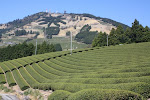 Now we, Sugimoto America, are very happy to announce that 2010 Shincha preorder has started.
Now we, Sugimoto America, are very happy to announce that 2010 Shincha preorder has started.Shincha literally means "new tea" in Japanese and is the very first cut of green tea. During the wintertime, tea plants absorb and stock nutrients from soil. When the spring arrives, the plants, full of energy and nutrients, begin to sprout and show the amazing color of vibrant green.
Shincha is technically equal to Sencha, which is made of young tea leaves only. But only the tea harvested in early spring is called "Shincha." Shincha has much more Theanine, the component of sweetness, than Sencha.
Just like the last year, we offer 3 kinds of Shincha - Temomi Shincha, Hashiri Shincha, and Hachiju Hachiya Shincha. Last year, surprisingly, there were so many inquiries for Temomi Shincha. Not only to the U.S., we sent the Temomi to France!
 Temomi Shincha
Temomi ShinchaTemomi means "hand kneading" in Japanese and Temomi Shincha is 100% hand-made green tea. When the Sen Cha was created centuries ago, this Temomi method is commonly used, but today machine replaces the labor. Recent years, Temomi technique is vanishing.
Temomi Shincha is a very special tea for a special occasion. If you would like to try the truly traditional taste of green tea, this is definitely your choice.

Hashiri Shincha
Hashiri means "early season" in Japanese. Our Hashiri Shincha is produced from very young leaves harvested at the end of April. These early-season leaves are very soft and contain a lot of sweetness. This is the taste of spring.
 Hachiju Hachiya Shincha
Hachiju Hachiya ShinchaHachiju Hachiya literally means "88 nights," and refers to the eighty-eighth day since the beginning of spring. The period of time lets tea plants matured, and Hachiju Hachiya tea leaves have the perfect balance of sweetness and bitterness.
Shincha is a special tea for Japanese people. I believe these Sinchas will herald the arrival of spring.

No comments:
Post a Comment